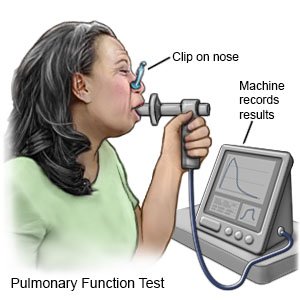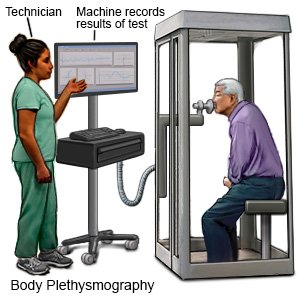Pulmonary Function Tests
Medically reviewed by Drugs.com. Last updated on Apr 6, 2025.
AMBULATORY CARE:
What you need to know about pulmonary function tests (PFTs):
PFTs measure how well your lungs work. PFTs may show the cause of breathing problems or how well treatments for a lung condition are working.
Seek care immediately if:
- Your shortness of breath does not get better after treatment, or it gets worse.
- You cough up blood.
Call your doctor or pulmonologist if:
- You have new or worsening symptoms.
- You have questions or concerns about your condition or care.
How to prepare for PFTs:
- Your healthcare provider will talk to you about how to prepare for these tests. You may need to stop taking certain medicines 4 to 24 hours before your tests. Your provider will tell you the medicines to take or not take on the day of your tests.
- If you use oxygen, you may need to stop using it for a short time before you have these tests.
- You may be told not to smoke, have caffeine, or exercise on the day of your tests.
- If you use dentures, you may be asked to remove them for the tests.
What will happen during PFTs:
- Spirometry measures how much air you breathe in and breathe out, and how fast you can blow air out. During this test, you will sit or stand next to a machine. A healthcare provider will place soft clips on your nose. He or she will tell you how to breathe into the machine. You will be asked to breathe normally several times. You will breathe in as deeply you can, and then breathe out forcefully for about 6 seconds. You will then be asked to breathe in deeply again. You may be given a breathing medicine during this test to see if it helps your lungs.

- Lung diffusion capacity measures how well your lungs can move oxygen into your bloodstream. For this test, you will breathe in a gas through a tube. You will be asked to hold your breath for about 10 seconds and then breathe out.
- Body plethysmography measures the amount of air in your lungs after you take a deep breath in. It also measures how much air stays in your lungs after you breathe out. You will sit inside a sealed box about the size of a phone booth. You will be asked to breathe into a tube that is connected to a computer. The healthcare provider will tell you how to breathe into this tube.

Return to daily activities:
You may restart your medicines and return to your usual daily activities immediately after these tests.
Risks of PFTs:
Deep breathing done during some tests may cause you to feel short of breath, dizzy, or lightheaded. It may also cause you to cough.
Follow up with your doctor or pulmonologist as directed:
You may need to return to go over your test results. Write down your questions so you remember to ask them during your visits.
© Copyright Merative 2025 Information is for End User's use only and may not be sold, redistributed or otherwise used for commercial purposes.
The above information is an educational aid only. It is not intended as medical advice for individual conditions or treatments. Talk to your doctor, nurse or pharmacist before following any medical regimen to see if it is safe and effective for you.
Further information
Always consult your healthcare provider to ensure the information displayed on this page applies to your personal circumstances.
